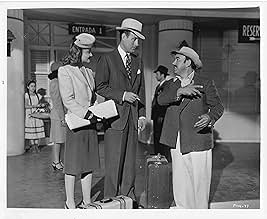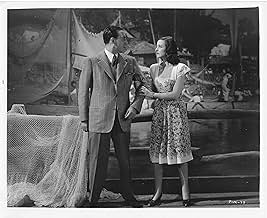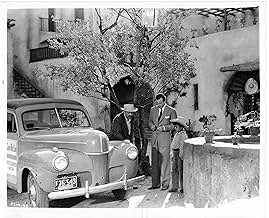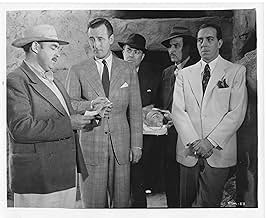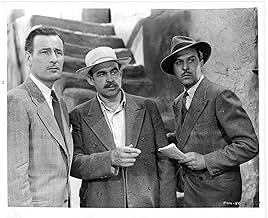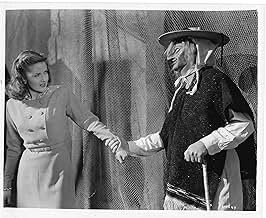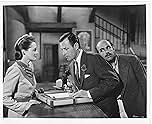IMDb RATING
6.1/10
859
YOUR RATING
An artist's daughter becomes suspicious when new paintings by her supposedly dead father begin turning up in New York. When a gallery owner is murdered, the Falcon and Miss Wade head for Mex... Read allAn artist's daughter becomes suspicious when new paintings by her supposedly dead father begin turning up in New York. When a gallery owner is murdered, the Falcon and Miss Wade head for Mexico City to investigate.An artist's daughter becomes suspicious when new paintings by her supposedly dead father begin turning up in New York. When a gallery owner is murdered, the Falcon and Miss Wade head for Mexico City to investigate.
- Director
- Writers
- Stars
Martha Vickers
- Barbara Wade
- (as Martha MacVicar)
Pedro de Cordoba
- Don Carlos Ybarra
- (as Pedro De Cordoba)
Chiche Baru
- Señorita
- (uncredited)
Ray Beltram
- Mexican Townsman
- (uncredited)
Edward Biby
- Commuter
- (uncredited)
Iris Bynam
- Maid
- (uncredited)
Nina Campana
- Dueña
- (uncredited)
Chester Carlisle
- Grenville
- (uncredited)
Wheaton Chambers
- Jarvis
- (uncredited)
- Director
- Writers
- All cast & crew
- Production, box office & more at IMDbPro
Featured reviews
For my time, I would much rather watch an earlier Falcon film. That's because the George Sanders films were usually better written and more exciting--as well as starred the wonderful Sanders. With THE FALCON'S BROTHER, Sanders' real-life brother, Tom Conway, took over the leading role since Sanders wanted out of the series in order to pursue other acting opportunities. Now this was a very logical choice, as Conway looked a lot like Sanders and also had a similar lovely melodious voice. But despite this, I still found myself missing Sanders, as to me he was THE Falcon and the earlier films were just were written better and seemed so much fresher.
By 1944, Conway's Falcon had fallen into a rather predictable pattern that must have worked well at the time because they made so many of these films during a three year stretch--a HUGE output of 9 films! The public loved them and the series was more popular than contemporaries Boston Blackie, The Lone Wolf and Crime Doctor. So, despite my complaints, the series did work. Of course, I would contend that averaging three films a year was exactly why the films seemed not quite as good as the earlier ones--they were rushed into production and didn't seem as smooth or engaging as earlier ones.
Now THE FALCON IN Mexico is a bit better than most films of this period thanks to a relatively simple but engaging mystery. A low-point in the series was THE FALCON OUT WEST and I think most of the problem with that film was that there were too many twists and turns and surprises. Plus putting Conway out West just didn't fit his style and personality, though Mexico seemed a much better change of venues.
The plot involves the possibility that a famous dead painter MIGHT actually be alive. Either that, or the damsel in distress is losing her mind, as she keeps thinking she's seen her dead father. The Falcon, naturally, comes to her aid and by the end the mystery's all naturally been revealed.
By 1944, Conway's Falcon had fallen into a rather predictable pattern that must have worked well at the time because they made so many of these films during a three year stretch--a HUGE output of 9 films! The public loved them and the series was more popular than contemporaries Boston Blackie, The Lone Wolf and Crime Doctor. So, despite my complaints, the series did work. Of course, I would contend that averaging three films a year was exactly why the films seemed not quite as good as the earlier ones--they were rushed into production and didn't seem as smooth or engaging as earlier ones.
Now THE FALCON IN Mexico is a bit better than most films of this period thanks to a relatively simple but engaging mystery. A low-point in the series was THE FALCON OUT WEST and I think most of the problem with that film was that there were too many twists and turns and surprises. Plus putting Conway out West just didn't fit his style and personality, though Mexico seemed a much better change of venues.
The plot involves the possibility that a famous dead painter MIGHT actually be alive. Either that, or the damsel in distress is losing her mind, as she keeps thinking she's seen her dead father. The Falcon, naturally, comes to her aid and by the end the mystery's all naturally been revealed.
Something happened to the Falcon on his flight down to Mexico. He was never the same after he landed.
For the first 15 minutes or so of this movie -- set in a large U.S. city -- everything is terrific. The Falcon meets two beautiful women, commits two minor crimes, finds a corpse, gets wrongly accused of murder, escapes from custody and learns that something mysterious is going on south of the border. It doesn't all happen in exactly that order, but there's plenty of fast-paced fun.
But once the Falcon and one of the women fly to Mexico, the excitement levels off. The plot slows to a crawl. Events, including murders, seem almost random, and even the characters appear bored at time. At one point, the Falcon warns a Mexican gentleman that somebody may try to kill his daughter. The man shrugs off the tip and assures our hero that Mexico is a very safe place. He's not even curious about where the threat comes from!
The problem with the main part of this movie is that there's so much Mexico, there's no room left for mystery. There's travelogue-style footage of lakes and mountains, and some of it is very good. There are songs in Spanish, performances of masked Mexican dancers and shots of Mexican fishermen at work. There are even stereotypical "comic" Mexicans who talk like Speedy Gonzales. But there's no suspense, and the ending is very weak.
Considering when it was made, "The Falcon in Mexico" probably had a public relations component. During World War II, the U.S. government encouraged Hollywood to portray Latin America in a favorable light. But in a mystery movie, an exotic setting goes only so far. After a crackerjack start, this little whodunit is ultimately unsatisfying. It's at its weakest where it should have been strongest.
For the first 15 minutes or so of this movie -- set in a large U.S. city -- everything is terrific. The Falcon meets two beautiful women, commits two minor crimes, finds a corpse, gets wrongly accused of murder, escapes from custody and learns that something mysterious is going on south of the border. It doesn't all happen in exactly that order, but there's plenty of fast-paced fun.
But once the Falcon and one of the women fly to Mexico, the excitement levels off. The plot slows to a crawl. Events, including murders, seem almost random, and even the characters appear bored at time. At one point, the Falcon warns a Mexican gentleman that somebody may try to kill his daughter. The man shrugs off the tip and assures our hero that Mexico is a very safe place. He's not even curious about where the threat comes from!
The problem with the main part of this movie is that there's so much Mexico, there's no room left for mystery. There's travelogue-style footage of lakes and mountains, and some of it is very good. There are songs in Spanish, performances of masked Mexican dancers and shots of Mexican fishermen at work. There are even stereotypical "comic" Mexicans who talk like Speedy Gonzales. But there's no suspense, and the ending is very weak.
Considering when it was made, "The Falcon in Mexico" probably had a public relations component. During World War II, the U.S. government encouraged Hollywood to portray Latin America in a favorable light. But in a mystery movie, an exotic setting goes only so far. After a crackerjack start, this little whodunit is ultimately unsatisfying. It's at its weakest where it should have been strongest.
Never far from women or trouble, Tom Lawrence meets both when he meets Dolores Ybarra trying to get into a door and recover a painting she did. Helping her, Lawrence realises he was duped and that the painting is of her, not by her. These trifling issues are put to one side when they discover a body in the building. The girl flees and, suspected of the murder (as usual), Lawrence does too. The problem with the painting is that the painter actually died 15 years earlier, but yet the portrait must have been done recently. Lawrence seeks out the artist's daughter Barbara, who reveals a mystery around her father's death and the two head to Mexico to investigate further.
After being Out West, the film series continues its attempts to freshen things up by "being places" rather than doing things. In this case we have a lazy travelogue that takes us to Mexico with lots of backdrops and footage (with supposedly a famous source!). The mystery starts out well enough and does offer intrigue to a point but it is pretty much lost in the delivery, which seems more interesting in providing a lot of footage of Mexico instead. This bothered me a bit because I was interested by the set up but this waned as I realised that the film itself wasn't that fussed. Berke's direction is fine I'm sure but he is continually overshadowed by the stock footage (supposedly shot by Orson Welles) which regularly takes centre stage. The film also features a couple of songs (a common filler in b-movie world), they aren't much cop here but do add a sanitised flavour of Mexico.
Conway is not as smooth as he was in some other of the Falcon films. He is still recognisable as the same character but it does feel like he is going through the motions somewhat with this one. He lacks much in the way of support here as well as his regular comic companions of the police and Goldie/Lefty are absent. Instead we have a bit of life from Paiva in a good sidekick character. Maris, Vickers, Currier, Callejo and others all do so-so jobs but nobody has much conviction about anything probably not helped by the material.
Overall then a fairly uninspiring entry in the series that continues the gimmick of the location from Out West. The stock footage is all well and good but the mystery becomes slack and uninteresting all too quickly.
After being Out West, the film series continues its attempts to freshen things up by "being places" rather than doing things. In this case we have a lazy travelogue that takes us to Mexico with lots of backdrops and footage (with supposedly a famous source!). The mystery starts out well enough and does offer intrigue to a point but it is pretty much lost in the delivery, which seems more interesting in providing a lot of footage of Mexico instead. This bothered me a bit because I was interested by the set up but this waned as I realised that the film itself wasn't that fussed. Berke's direction is fine I'm sure but he is continually overshadowed by the stock footage (supposedly shot by Orson Welles) which regularly takes centre stage. The film also features a couple of songs (a common filler in b-movie world), they aren't much cop here but do add a sanitised flavour of Mexico.
Conway is not as smooth as he was in some other of the Falcon films. He is still recognisable as the same character but it does feel like he is going through the motions somewhat with this one. He lacks much in the way of support here as well as his regular comic companions of the police and Goldie/Lefty are absent. Instead we have a bit of life from Paiva in a good sidekick character. Maris, Vickers, Currier, Callejo and others all do so-so jobs but nobody has much conviction about anything probably not helped by the material.
Overall then a fairly uninspiring entry in the series that continues the gimmick of the location from Out West. The stock footage is all well and good but the mystery becomes slack and uninteresting all too quickly.
Falcon in Mexico, The (1944)
** (out of 4)
The Falcon (Tom Conway) travels to Mexico where he gets involved with murder and a mysterious painting. This entry gets a minor leg up from the Mexican locations, which are probably just backlot shots but the actual mystery itself is rather bland. The screenplay is all over the place and even when the killer was revealed it still didn't make too much sense. Conway is really hit and miss in this series and I'd have to call him a major miss here. The supporting cast isn't any better and many of the members from previous films, including Cliff Clark, are missing here, which doesn't help matters.
** (out of 4)
The Falcon (Tom Conway) travels to Mexico where he gets involved with murder and a mysterious painting. This entry gets a minor leg up from the Mexican locations, which are probably just backlot shots but the actual mystery itself is rather bland. The screenplay is all over the place and even when the killer was revealed it still didn't make too much sense. Conway is really hit and miss in this series and I'd have to call him a major miss here. The supporting cast isn't any better and many of the members from previous films, including Cliff Clark, are missing here, which doesn't help matters.
This "Falcon" entry relocates to Mexico and features all the stock characters and situations that one would expect from Hollywood in that setting - some of which (the repeated footage of songs in the cantina, for instance) is obviously used simply as filler. But what raises the resulting film somewhat above average is the unexpected twist it manages to place on much of its material. Barbara's exotic young stepmother turns out to be genuinely attached to her, for instance, while the grinning, thick-witted Mexican who seems to be playing a part in a bad film turns out to be a very cool bird indeed.
There is some artful photography and some smart dialogue, and while there does seem to be a certain amount of tourist advertising blatantly inserted -- literally, as in photographs of travel brochures -- this film is more interesting than I thought it was going to be. Oddly enough, while it features a number of murders they are all left more or less in the background to the main mystery, which is the question of who faked the stolen portrait... or indeed, if it was faked at all...
There is some artful photography and some smart dialogue, and while there does seem to be a certain amount of tourist advertising blatantly inserted -- literally, as in photographs of travel brochures -- this film is more interesting than I thought it was going to be. Oddly enough, while it features a number of murders they are all left more or less in the background to the main mystery, which is the question of who faked the stolen portrait... or indeed, if it was faked at all...
Did you know
- TriviaSome of the Latin American exterior footage that is seen behind the opening credits, and which is inter-cut with the studio-shot scenes and projected behind the cast in some sequences, is rumored but unconfirmed to have come from Orson Welles' never-completed and Brazilian-located RKO documentary "It's All True"; that project was itself the subject of a documentary, It's All True (1993).
- GoofsWhen Tom & Barbara fly to Mexico, they leave on a plane with AMERICAN (airlines) on the rear of the plane. When they land, they arrive on a PAN AMERICAN plane.
- ConnectionsFollowed by The Falcon in Hollywood (1944)
- SoundtracksNegrita no me dejes
(uncredited)
Music and Lyrics by Aaron González
Played on guitars by, and sung by Ruth Álvarez and Nita Hunter at the hotel
Details
- Release date
- Country of origin
- Languages
- Also known as
- The Falcon in Mexico
- Filming locations
- Lake Patzcuaro, Michoacan, Mexico("butterfly" fishing boats)
- Production company
- See more company credits at IMDbPro
- Runtime1 hour 10 minutes
- Color
- Aspect ratio
- 1.37 : 1
Contribute to this page
Suggest an edit or add missing content


